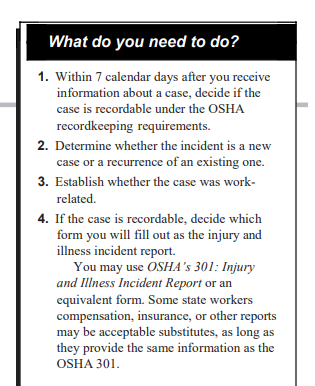OSHA Recordkeeping: A Deeper Dive into the Requirements

Have you ever wondered, “How do I record an injury or illness on my OSHA 300 log?” or “Is there additional documentation that I need to maintain?” This is a topic that many businesses have questions about and a frequent topic of The Safety Net. This post will address a few documentation details you might not be aware of and is a follow up to Steve Badger’s previous post, “The OSHA Reporting Forms- It’s That Time of Year Again.” In addition to these blog posts, MEMIC will also host a webinar on the subject coming up soon. Read to the end for a link to our registration page.
The Occupational Safety and Health Administration (OSHA) Recordkeeping Regulations, 29 CFR Part 1904, require that records be maintained by most private sector employers who have 10 or more employees. There are some exceptions for partially exempt industries. You can review the exemption list here. If your organization is required to maintain OSHA records, the OSHA website can be extremely helpful in providing key resources to assist with compliance to this regulation.
The OSHA Recordkeeping Assistance Page can certainly help you to begin to understand the overall requirements, the necessary forms, and record retention rules. The information on this page can help get you started as it provides guidance for completing the forms for injury and illness recordkeeping that you can elect to use for tracking an OSHA recordable injury or illness.
The regulatory text for the Recordkeeping standard is a bit unique in that it is primarily written in a Question-and-Answer format throughout. Additionally, there is detailed guidance for the recordkeeping rule that is organized by designated regulatory section. This includes the sections on recording criteria; determination of work-relatedness, and General Recording Criteria.
There are a few exceptions that are important to review to ensure employee privacy is maintained. The employee’s name shall not be placed on the OSHA 300 log but rather the line item must be categorized as a “privacy case” in the space normally used for the employee’s name if the following types of injuries or illness were to occur:
- An injury of illness to an intimate body part of to the reproductive system
- An injury of illness resulting from a sexual assault
- A mental illness
- A case of HIV infection, hepatitis, or tuberculosis
- A needlestick injury or cut from a sharp object that is contaminated with blood or other potentially infectious material and
- Other illnesses if the employee independently and voluntarily requests that his or her name is not entered on the log.
When you are logging an incident, did you know that the day of the injury or illness is not counted on the OSHA 300 log? You begin counting days away on the day after the injury occurred or the illness began.
Lastly, incidents must be investigated and documented in a timely manner. The OSHA instructional document states that within 7 calendar days of notification of a case, determination of recordability needs to be made and the illness and injury report completed.

Despite the fact that the OSHA standards are generally very rigid in compliance and application, there is a bit of nuance that applies to the OSHA recordkeeping regulations. On March 10, 2022, at 10:00am EST, MEMIC will clarify these questions through demonstration of an OSHA 300 log completion in a live webinar: OSHA recordkeeping: A Deeper Dive into the OSHA 300 Log. This webinar is free to all MEMIC policyholders but does require registration. Click Here to register for this training event.

